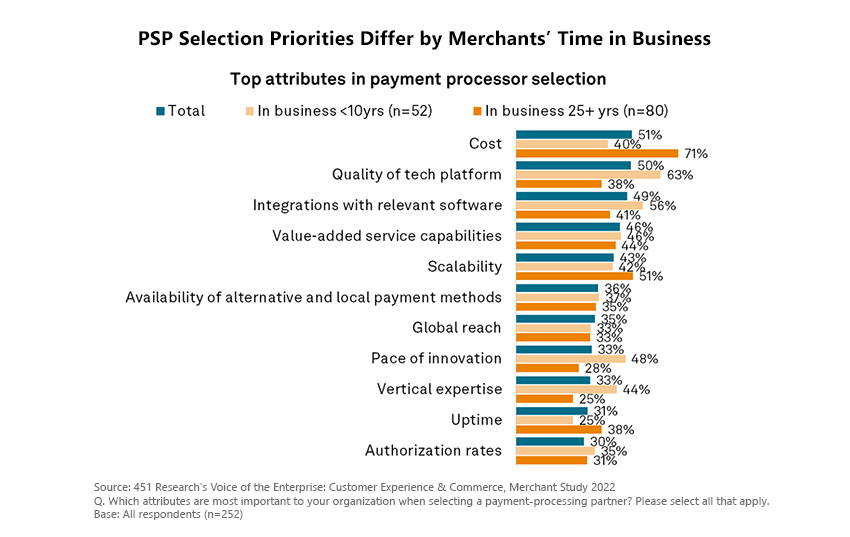
While payment service providers may like to believe otherwise, cost will likely always be a top factor that merchants consider when choosing their primary payment service provider (PSP). In fact, 66% of respondents to a recent 451 Research survey note that keeping payment acceptance costs as low as possible is a high priority for their business. Cost remains the number one attribute merchants consider when selecting a PSP, although encouragingly, additional factors like quality of tech platform, software integrations and value-added service are not far behind – a signal that more merchants are weighing their PSP selection decisions against multiple business priorities.
Payment service provider selection criteria
The top attributes merchants seek in PSPs are by no means universally consistent, especially when it comes to the length of time they have been in business. Traditional factors in the payments industry – cost, uptime and scalability – matter considerably more to merchants that have been in business for over 25 years. Cost is by far the number one factor for merchants in business for 25-plus years when selecting a PSP (71%), but considerably less so for merchants in business fewer than 10 years (40%), where it falls outside of the top five attributes they prioritize. Scalability and uptime also matter more to older merchants than newer ones (9-point and 13-point differentials, respectively). One plausible reason for these differences is that older companies’ operations have likely grown more expansive over time, and therefore the consequences that payments have on their business (both in terms of expense and revenue) have intensified.

Compared with their longer-tenured counterparts, merchants in business for fewer than 10 years place significantly more emphasis on the quality of a PSP’s tech platform (26-point differential), their vertical expertise (19-point differential), integrations with relevant software (15-point differential) and pace of innovation (10-point differential). This tells us that newer merchants favor PSPs that understand them and can plug and play quickly, while providing them with a strong platform to build and expand their business. We believe younger merchants are more likely to think of payments as a growth lever for their business and are seeking PSPs that can help accelerate that growth.

Generally, while payment-processing fundamentals are more top of mind for older merchants, newer ones are placing greater emphasis on technology and innovation. Overall, it is also evident that a wide variety of factors influence PSP selection, with each attribute selected by at least one-quarter or more of respondents. There isn’t necessarily a right answer regarding which PSP attributes matter more, and priorities will inevitably differ based on business requirements.
We believe merchants should always take into consideration the total cost of payments when choosing a PSP. For instance, it is not uncommon for a merchant to quickly eliminate the PSP with the highest processing rate when reviewing requests for proposals. However, it is entirely possible that the higher rate could be offset by the PSP’s ability to increase authorization rates or reduce developer hours and enhance conversions thanks to the PSP’s preexisting integrations with alternative payment methods. Similarly, a PSP with the lowest rate may also have high instances of downtime, which would quickly negate any potential cost savings.
The rise of the multi-processor approach to payments
The wide variety of merchant payment priorities is a key reason why it has become common practice to enlist multiple PSPs to address specific business needs – 59% of respondents to a 451 Research survey indicate that their business prefers this approach. Given the significant variations in payment types and regulations from country to country, multinational merchants (particularly those operating in three or more regions) exhibit the strongest preference for leveraging multiple PSPs (71%). There are numerous drivers that influence merchants’ decisions to work with more than one PSP, including a desire for flexibility (e.g., reducing vendor lock-in), cost optimization (e.g., least-cost routing) and accessing multiple best-of-breed capabilities (e.g., a PIN debit routing engine, a fraud-prevention tool).

The tradeoff for utilizing a multi-PSP model is that it creates added operational complexity. Simply put, more partners means more integrations to maintain, and ultimately more fragmentation in merchants’ payment environments. Many merchants lack the in-house resources to fully extract these benefits – consider that 57% of respondents highly agree that their business needs to reduce the time developers spend on payment functions, rising to 71% of respondents whose business generates more than $500 million in annual revenue.
Want insights on fintech trends delivered to your inbox? Join the 451 Alliance.
